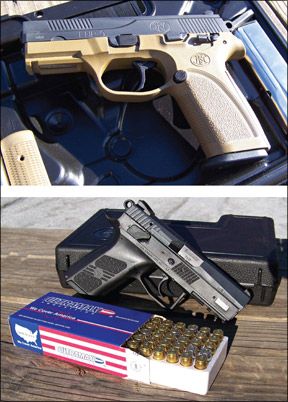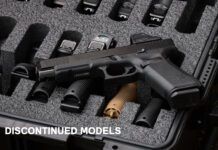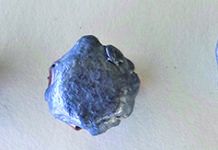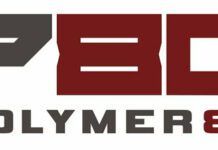The double-action first-shot self-loading pistol continues being popular because many shooters are uncomfortable with the requirement to keep a single-action pistol cocked and locked, hammer back, safety on. Others do not trust the lack of a manual safety in the double-action-only pistol. These shooters are more comfortable with a long first-shot double-action trigger press. The double-action first shot seems to offer the best of both worlds. This is a prime example of handling features taking advantage over range performance. The double-action-first-shot pistol will never win a combat competition, but many personal-defense shooters favor it. The long double-action trigger is a safety feature that requires 10 pounds or more of pressure to fire the handgun. If you need real precision, you have the option of a crisp single-action trigger press. The double-action-first-shot action transferred to the polymer-frame handgun offers light weight, low maintenance, and low expense, and two pistols like that we tested recently were the FNH-USA FNP-9 USG Flat Dark Earth (FDE) 9mm, $599, and the CZ-USA CZ P07 Duty No. 91186 9mm, $575. Each was individual enough that there were clear choices based on personal preference, but we were also struck by how similar these pistols are. The magazines, hammers and even many of the internal parts were similar in appearance.

Each handgun represented a different viewpoint. The FNH pistol is probably better suited as a holster gun for the Armed Services or as a home defender than for concealed carry, although it is light enough for concealed carry. The CZ may be better suited as a concealed carry handgun. Neither is a small pistol. The FNH is a result of the Armed Services requests for new pistol designs, although no contract test program or clear outline for specifications is forthcoming. No maker wishes to be left out of these competitions if they emerge. The pistol is available in 9mm, 40 S&W and 45 ACP. The CZ is an update in polymer of the proven CZ 75 design, with the new Omega action.
We tested each in 9mm Luger caliber. The 9mm is still an immensely popular handgun, and improvements in bullet technology and the availability of 9mm +P and +P+ loads make the caliber suitable for personal defense. Truth be told, in such light handguns the 9mm caliber is all the average shooter is probably willing to master.
FNH-USA FNP-9 USG
Flat Dark Earth (FDE) 9mm, $599
The FN is a businesslike pistol with a good appearance. The polymer frame is finished in earth tone. The frame is stippled in the right places, and unlike many polymer-frame guns, the stippling actually aids in holding the pistol. The backstrap may be fitted with either a curved or a flat backstrap panel. Most shooters found the flat strap the most comfortable. The curved strap would be best for those with very large hands. The magazine well looks cavernous. It is easy to quickly guide a tapered high-capacity magazine into the magazine well. The magazine release looked as if it would be easily engaged by accident, but the polymer molding that protects it does its job well.
The frame is molded with a rail for a combat light. The slide is wider than some, which is an issue if the pistol is carried concealed, but then the pistol is rated for NATO specification ammunition. We feel that this is the pistol with which to fire thousands of high-power rounds, if you so desire. The slide features forward cocking serrations (the CZ does not) and an external extractor that doubles as a loaded-chamber indicator. The FN uses the Glock/SIG-type lock up. The barrel butts into the ejection port to lock up, and there are angled cramming surfaces on the bottom barrel lugs.
The pistol fieldstrips easily, once you are certain the magazine is removed. Lock the slide to the rear, rotate the disassembly lever down, and the slide runs off the frame. The trigger action is smooth enough at 11 pounds in the double-action mode. The single-action trigger breaks at a clean 4 pounds. The ambidextrous decocker was easily handled. It is not likely to be actuated during firing, but it is well protected by bumps in the molded polymer frame. This version also featured the manual safety option. The safety may be applied while the hammer is cocked. More about this later.
Upon initial examination the only complaint our testers had was with the sights. The sights are average 1980s-style service sights. We would have liked to have seen larger sights with a more precise sight picture. FN missed a chance to offer a truly improved pistol. This is a fresh design with much to recommend it, but the sights left us cold. The frame seemed a little large as well, but comfortable enough.
We fired the pistol on the combat course at 7, 10, and 15 yards. The pistol was fast on target and controllable in rapid fire, with minimum muzzle flip. As double-action-first-shot pistols go, the pistol could be counted on for a fast hit as well as any others of the type. One of our raters, a military intelligence officer, was able to draw, work the trigger, and get a fast hit on the 8-inch gong at 15 yards every time. But he has plenty of time in with the double-action Beretta. He rated the FN a shade ahead of the Beretta, and found its 10-ounce-lighter frame welcome. Despite the light weight of the FN, all found the piece comfortable to fire.
A complaint was slow trigger reset. The main complaints came from 1911 and Glock shooters, who are used to a rapid trigger reset. The FN reset is comparable to the SIG double-action pistol in this regard. While a first-class handgun shooter may feel limited, in practical terms the FN may be fired as quickly and accurately as any other double-action pistol at close range. We found the FNs cadence of fire is set not by how quickly you are able to press the trigger, but by how quickly you are able to realign the sights.
During the course of our evaluation we let several of our raters run the pistol for function, with favorable results. The FN went 300 rounds without cleaning. There were no failures to feed, chamber, fire, or eject. The magazines fell free, allowing rapid magazine changes. The only negative comment was concerning the sights. We did not ask for comparisons to other action types but rather rated the pistol on its own merits as a double-action design.
One advantage noted by experienced shooters was the on Safe option. Even though all agreed they would carry a double-action pistol off Safe at ready, the ability to quickly place the safety on during tactical movement was appreciated. Rather than decocking the pistol for safety, you might simply place the safety on and take cover, not resorting to decocking the hammer and working the long double-action trigger again. The CZ was set up as a decocker only, however, we did not include this difference as part of the rating, as the CZ is easily converted to the separate safety system. Use the variation that suits you, but the safety-enabled version has merit in a tactical pistol. It took a light touch to lower the safety and not decock the hammer.
After we had carefully cleaned the pistol, we conducted accuracy tests with three different loads. We were gratified by the accuracy of the pistol. A minor drawback was sight regulation. The pistol fired 2 inches high plus a little to the left. A drift with a punch adjusted the sights for proper windage. A few groups of five shots at 25 yards were well under 2 inches, but, overall, the pistol gave a 2-inch average.
Our Team Said: The FN pistol performed flawlessly with perfect reliability. Accuracy was good. The pistol was comfortable to fire and the controls were crisp. There were two things we did not like. The pistol was more bulky in the grip than necessary, but that is an attribute of the breed. There was little excuse for the poor sights. FN missed a chance to provide first-class sights on its new pistol. While the FN was more expensive than the CZ, the FN came with three magazines. That is unheard of these days. Despite the poor sights, the FN was more accurate than the CZ. The takedown and handling made for easy maintenance. The FN is the better buy.
CZ-USA CZ P07 Duty No. 91186 9mm, $575
One of our raters feels that the original CZ 75 is among the three most reliable pistols in the world, along with the 1911 and the Browning High Power. But how well that transferred to the P07 would be put to the test. The pistols polymer frame was well stippled and checkered in the right places, but we could not find a function for the checkering near the slide lock. The pistols frame is comfortable, and slightly thinner than the FN. The P07 will fit average to small hands well. The decocker is a handy design that falls under the thumb easily. The frame features a light rail. The hooked trigger guard appears odd, but it worked well with the combat light butted against it. Still, the hooked guard is dated on a modern design, our shooters said.
The slide is low and one of the advantages of the pistol. The slide rides inside the frame. This allows a lower bore axis and increases accuracy potential by giving the long bearing surfaces more contact with the frame. There are no forward cocking serrations, and the slide is a little more difficult to grasp and rack than the FN.
Our shooters thought the P07 gained a great advantage with its sights. These are true high-visibility combat sights well suited for fast work or for precision fire. We would have liked to have had these sights on the FN pistol!
Trigger action was smooth, with an estimated 11 pounds of compression in double action. The new Omega action is smoother than the original CZ 75, but feels different. There is a good bit of takeup in the single-action trigger press. Once the slack is taken, the trigger breaks cleanly enough at 4.5 pounds.
During the firing evaluation the pistol digested 300 rounds of ball ammunition without complaint. Combat shooting was impressive, but there were a couple of drawbacks. The magazine did not drop free, but instead had to be pulled free, slowing combat loads. One of the raters confused the decocker with the slide lock several times, and he is an experienced shooter. He acclimated, but the magazine failing to fall free is as big a fault as you wish to make it.
On the plus side, the pressure needed to load a full 16 rounds in the CZ was seen as a little less than the FN, although the CZ magazines are not as tall.
The primary complaint concerning the P07 was its takedown. Like the FN, the CZ uses the SIG/Glock lockup by butting the barrel into the ejection port.To disassemble the piece, the slide lock is taken out much in the manner of the original CZ 75. To remove the slide lock, you must simultaneously press the lock out and press the slide to the rear. A captive slide lock is not likely to be lost and is preferable in a modern polymer-frame pistol.
The slide lock was very stiff in removal. The slide ran off the frame easily, but when we removed the recoil spring and guide, it was difficult to reinsert. One of our raters was comparing the pistols on his work bench and resorted to asking his wife and brother to help him reassemble the pistol! One stabilized the slide while pressure was exerted to reassemble the spring and guide rod in the slide.
Here at Gun Tests we handle a lot of pistols, but the P07 taxed the patience of our raters in reassembly and did not become easier despite firing hundreds of rounds of ammunition.
The pistol is well made of good material, and fit and finish were good. Firing impressions of the CZ were good. We fired the pistol on combat courses at 5, 7, and 10 yards. There were no failures to feed, chamber, fire or eject. Felt recoil was greater than the FN, although the CZ is slightly heavier. Conversely, muzzle flip was less due to the low bore axis. The 9mm does not kick much, but just the same there was a noticeable difference. The wide frame of the FN spread recoil out in the palm more.
Elsewhere, the sights were universally praised. In combat shooting, the P07 seemed to have an edge. However, the failure of the magazine to drop free slowed reloads, and more than one rater pinched his shooting hand when reinserting the magazine. Interested shooters and raters used the pistol until the round count was 300 rounds. At that point the pistol was cleaned and an accuracy test undertaken.
Considering the width and short sight radius of the CZ, accuracy results were good. With a short sight radius you are far more likely to misalign the front sight, and we are certain that we are not perfect shots. Just the same, using three accurate and proven loadings the CZ averaged 3 inches for 25-yard groups. This is more than acceptable for a personal defense or service pistol, although we would like to have seen more accuracy.


















